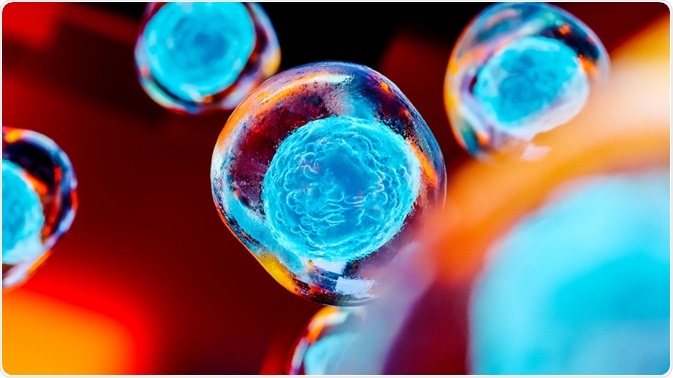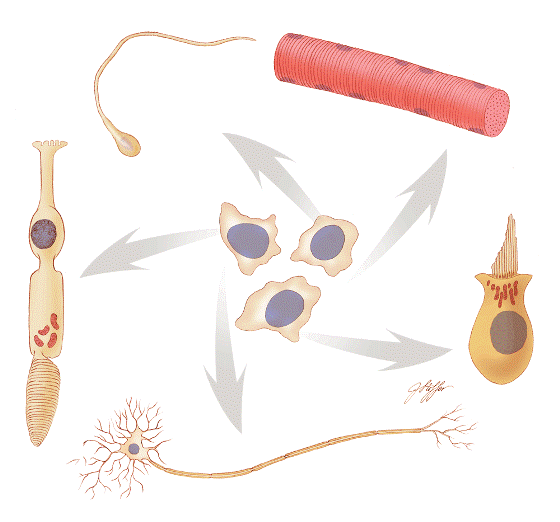Stem cells are undifferentiated cells that are capable of self-renewal or differentiation into a specialized cell. They exist within areas of the body known as biological niches and are essential for growth during childhood, and homeostasis throughout adulthood.
Thus, understanding the biological processes that underpin these cells can have invaluable implications for regenerative medicine, disease treatment, and injury recovery. This article describes each type of stem cell, as well as some key landmark discoveries and the major applications of stem cells in medicine and research.
 pinkeyes | Shutterstock
pinkeyes | Shutterstock
What are stem cells?
The defining characteristic of stem cells is that they can differentiate into several different cell types during growth and development. This not only has implications during early life, but also following injury where stem cells act as an internal repair mechanism by replenishing the injured or dead cells. There are two main features of stem cells that make it unique.
Unspecialized nature
Stem cells are not differentiated to have specific structures and functions. For example, an unspecialized stem cell cannot carry oxygen like a red blood cell or pump blood like a heart cell. However, upon receiving appropriate signals, it can form into different types of specialized cells, like muscle cells, blood cells, etc.
Differentiation potential
The process of differentiation allows unspecialized stem cells to acquire specific functions and properties. The signals that cue this transition can be intrinsic (from within the cell) or extrinsic (from outside the cell). Extrinsic signals that can trigger this transition may be in the form of mechanical or chemical cues from the neighboring cells.
The differentiation potential of stem cells is variable in different organs. Some organs, including gut and bone marrow, regularly undergo division to repair and replenish the damaged cells. However, in organs such as the pancreas and heart the frequency of stem cell division and differentiation is much lower.

Where do stem cells come from?
Human umbilical cord
The cord blood can be collected from the umbilical cord of a baby after its birth and consists of hematopoietic and mesenchymal stem cells. The hematopoietic stem cells can form red blood cells and cells of the immune system, while the mesenchymal stem cells can generate bone, cartilage, and other types of tissues. The cord blood can also be collected and stored in cord blood banks for future use.
Bone marrow
Bone marrow is a soft gelatinous tissue found at the center of bones. Mesenchymal stem cells were first found in bone marrow, and it is still the most frequently used source of mesenchymal stem cells. Subsequently, hematopoietic or blood stem cells were also found in the marrow, making it an attractive candidate for regenerative medicine and therapeutic purposes.
Adipose tissue
The adipose tissue-derived stem cells are mesenchymal cells that have the potential for self-renewal and multipotency. They can differentiate into adipocytes, chondrocytes, myocytes, osteoblasts, and neurocytes, in addition to other cell types. These stem cells have been shown to have critical roles in reconstructive and tissue engineering fields to develop new treatments.
Amniotic fluid
Amniotic fluid is the liquid that surrounds the amnion or the sac that encompasses the fetus. Both the amniotic membrane and amniotic fluid are good sources of embryonic stem cells that can multiply and form any type of cell. Although the amniotic fluid and membrane are usually discarded after birth, recently they are being cryopreserved or frozen for future therapeutic use.
Types of stem cells
Stem cell potency
On the basis of their differentiation potential, stem cells can be classified into four types: totipotent, pluripotent, multipotent, and unipotent.
Totipotent cells
Totipotent cells can differentiate into all types of cells. For example, the zygote formed during the fertilization of an egg and the first few cells after division are totipotent and have the potential to develop into all types of cells in the body.
Pluripotent cells
Pluripotent cells can develop into almost all types of cells. These include embryonic stem cells, cells derived from the germ layers (mesoderm, ectoderm, endoderm), and cells formed during the early stages of embryonic stem cell differentiation.
Multipotent, oligopotent, and unipotent cells
Multipotent cells can divide into closely-related cells. For example, the hematopoietic stem cells can develop into red blood cells, white blood cells, and platelets. Oligopotent cells can develop into a few cell types, and include lymphoid or myeloid stem cells, while unipotent cells, such as muscle stem cells can only develop into cells of their own type.
What are stem cells? - Craig A. Kohn
Stem cell sources
Based on their origin, stem cells can be divided between early (or embryonic) and mature (or adult).
Embryonic stem cells
The embryonic stem cells are found in the inner cell mass of the blastocyst post five days of development. These cells are potentially immortal and are derived from embryos before they implant themselves in the uterus. These cells are typically 4–5 days old and are called blastocysts–a hollow microscopic ball of cells.
Adult stem cells
Adult stem cells are undifferentiated cells that are totipotent or pluripotent. These cells are found in various locations in the body and assist in maintaining healthy cell numbers and replenishing dying or injured cells.
Induced pluripotent cells
Recently, a new category of stem cells has emerged that originate from somatic cells and can be reprogrammed by scientists back to their pluripotent stage. This was done by manipulating the expression of a set of genes. As somatic cells are coaxed into pluripotent cells in this category, they have been termed as “induced pluripotent cells”.
What is stem cell lineage?
Stem cells usually undergo two kinds of cell division: symmetric and asymmetric. In symmetric division, two identical daughter cells with stem cell properties are generated post cell division. In asymmetric division, one stem cell and one progenitor cell are generated.
The progenitor cells have limited potential for self-renewal and after several cycles of division, give rise to differentiated mature cells. However, it is often difficult to locate stem cells as tissues contain large numbers of several types of cells.
Lineage analysis is one method used to tackle this problem. In this method, a single cell is marked such that it not only marks the target cell but also its daughter cells. Thus, the number, location, movement, and lifetime of a stem cell and its daughter cells can be tracked. The lineage analysis of stem cells helps to discover and identify stem cell niches that replace cells during a tissue’s lifetime.
Landmark discoveries in the history of stem cell research
One of the earliest experiments in this field was performed by Sir John Gordon during his Ph.D. in 1962. He removed the nucleus of a developing frog embryo during the blastula stage and injected it into an egg cell from which the nucleus was removed.
In most cases, the egg could develop into frog tadpoles, showing that nuclei from differentiated cells still had the potential to develop into any cells. This study formed the basis of reproductive cloning that led to the creation of Dolly, the cloned sheep.
1996: Dolly the sheep cloned
Another major discovery was the culturing of embryonic stem cells from mouse blastocysts in 1981. Subsequently, embryonic stem cells were also cultured from human blastocysts.
A landmark discovery was made when Shinya Yamanaka and his colleagues were able to induce somatic cells into pluripotent stem cells by introducing a set of 24 transcription factors. He was awarded the Nobel Prize in Medicine for this discovery in 2012, along with Sir John Gurdon.
Ethical issues surrounding embryonic stem cells
Recently, autologous induced pluripotent cells were used to treat macular degeneration in human studies. In another study, the epidermis was completely reconstructed in a patient with epidermolysis bullosa. There have also been advancements in organoids, three-dimensional structures that attempt to mimic the structure and function of organs.
These organoids can be generated from stem cells, induced pluripotent cells, biopsy samples, etc., and can be used for tissue transplantations. The creation of organoids has raised critical questions on ownership, storage, donor, and manipulation rights of these structures. Although they are not completely mature functionally, the extent to which organoids can be allowed to mature needs to be discussed.
The “14-day rule” has been set by the International Society for Stem Cell Research (ISSCR), which dictates that stem cell research on embryos needs to be terminated at two weeks post-fertilization. This time correlates with the emergence of the primitive streak, the first brain and spinal cord structure.
The advances in gene editing have also opened several doors for ethical cross-questioning, where the ISSCR has mandated that all steps of stem cell research and gene editing research should be transparent. Recently, however, there have been news reports that claimed that the first gene edited babies have been made in China, but this claim still needs to be substantiated.
Technical issues associated with induced pluripotent stem cells
Studies show that induced pluripotent cells have greater diversity than embryonic stem cells. This difference has been proposed to arise from epigenetic memory, genetic background, reprogramming, etc. Two studies show that cells present in the transitional phase are markedly different from the original and fully reprogrammed cells.
While many induced pluripotent cells show similar morphology and gene expression, they also have a poor quality of differentiation, low rate of growth, errors in transcription, DNA methylation, etc. Also, one of the factors used to reprogram the somatic cells, KLF4, can disrupt neurogenesis of induced pluripotent stem cells. Thus, further understanding of factor-induced reprogramming is needed.
Key applications of stem cells
Therapeutic purposes
Apart from bone marrow transplantation, stem cell therapeutics is still in the developmental stages. Attempts are being made to use stem cells in treating type I Diabetes, Parkinson's disease, Huntington's disease, celiac disease, cardiac failure, etc. However, bone marrow transplants, where stem cells are transplanted from the bone marrow, is a well applied and known application. The bone marrow stem cells can help in repopulating different blood types after radiotherapy.
Skin replacement
Stem cells are currently being used to grow skin from the plucked hair of a patient. The hair follicles contain skin stem cells or keratinocytes, and these cells can be isolated and cultured to grow an epithelial sheet. This method can help to reduce the need to use skin grafts from other people, lowering the chances of rejection.
Brain cell transplantation
Stem cells can be employed to generate dopamine–a chemical that is lacking in patients suffering from Parkinson's disease. However, in some cases, patients developed side-effects, suggesting the presence of very high levels of dopamine or over-sensitization in this method.
Further Reading